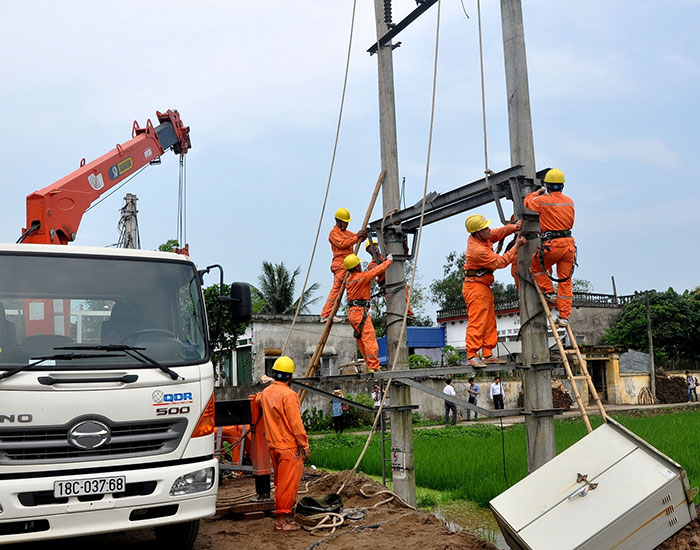No products in the basket.
NEW & EVENT
Electricity industry of Vietnam: Journey to contribute to the country’s development
On the occasion of the 65th anniversary of the Industry and Trade’s traditional day, the journalist of the Industry and Trade Newspaper had an interview with Professor, Academician Tran Dinh Long – Vice Chairman of Vietnam Electricity Association on the contributions of the Electricity Industry in industrialization and modernization of the country.
As a person attached to the Electricity industry of Vietnam through teaching as well as participating in management activities, how do you assess the achievements of the Electricity industry over the years?
With the mission of supplying enough electricity to the country, in recent years, Vietnam’s electricity industry has made great progress with many proud achievements.
From the negligible and poor source and grid since 1954, our country now has a solid electricity system with a total capacity of more than 38,800 MW, the national grid has covered the whole country. with over 6,000 km of 500 kV lines, 30,000 km of lines from 110 kV-220 kV and hundreds of thousands of km of distribution networks of all kinds. The annual electricity production reached over 150 billion kWh, the commercial electricity in 2015 reached 143.34 billion kWh. Electricity output per capita nationwide reached more than 1,400 kWh / year.
Along with that, the Electricity Industry has successfully implemented the program of rural electrification, pulling and supplying electricity to remote, border areas and islands. By 2015, nearly 100% of communes and over 98% of households have access to electricity. Although the Electricity industry has many compliments and criticisms, this is something that no one can deny.
 Over the years, the Electricity Industry has made efforts to implement the rural electrification program |
Over the past years, the electricity industry has also been constantly innovating, approaching science and technology, new technologies and information technology in order to improve the management capacity, production and business efficiency, and customer service. Construction and completion of large hydroelectric plants for electricity generation; put advanced gas turbine technology into the construction, efficient management and operation of thermal power plants. In the power transmission technology, a 500 kV ultra-high voltage line has been built from the North to the South, merging 3 previously operated electricity systems into a national and unified operating system. Vietnam is also one of the countries with the highest rural electrification rates in the world; Access time to electricity is constantly being improved and appreciated by international organizations.
Another achievement, it can be added that in management, the electricity industry has changed from monopoly, subject to many social complaints to a market mechanism with many better and better service indicators.
According to Professor, what time is the highlight of the outstanding development of the Electricity industry?
The year 1994 marked the growth of Vietnam’s electricity industry through the completion of the construction of a 500 kV ultra-high voltage line using the most advanced transmission technology at the time; then the establishment of the Electricity Corporation, the National Load Dispatch Center. After that, a series of electricity works in all regions were built and put into generation.
From 1954 to the 1990s, due to the war and resolving the consequences of the war, the power supply was always short of, unstable quality. In 90, the total capacity of the whole country was only about 1,800 MW, the electricity output was about 8-10 billion kWh. Electricity is used as a contract, there is no electricity meter, but the power loss happens frequently, the electricity quality is flickering, sometimes only used for living lighting.
The operation of the North-South 500kV transmission line not only plays a role in linking regional power grids, connecting power plants to the system, basically solving the power shortage of the South and the Central, but also. become the premise for the rapid development of electricity system today.
How does the Electricity sector contribute to the development of Industry and Trade and the country’s economy, Professor?
To develop the country’s economy, electricity must be one step ahead. Power projects not only create many socio-economic benefits for the locality such as increasing industrial value, creating jobs, social security, budget revenues, creating an environment to attract investment. At the same time, it also contributes to the promotion of other industries from industry, construction, agriculture to trade and services … For example, when the 500kV North – South circuit 1 line is put into operation, the speed The growth of commercial electricity of the whole country increased from 5-6% in the period of 1990-1992 to over 18% in the period of 1993-1997, of which the Central and Southern regions was 21%. As a result, the average industrial output growth rate reached 12-14% in the period 1990-1995, exceeding the targets set out by the Party’s Seventh National Congress.
Just look at the achievements of the Industry and Trade sector, the country in recent years, you will see the contribution of the Electricity industry. From negligible up to now, the Electricity industry has made provision, providing sufficient demand for loads with the quality and service constantly increasing, contributing to improving the national competitiveness and attracting investment; help transform regional economic structure; promote the production of goods for consumption and export.

